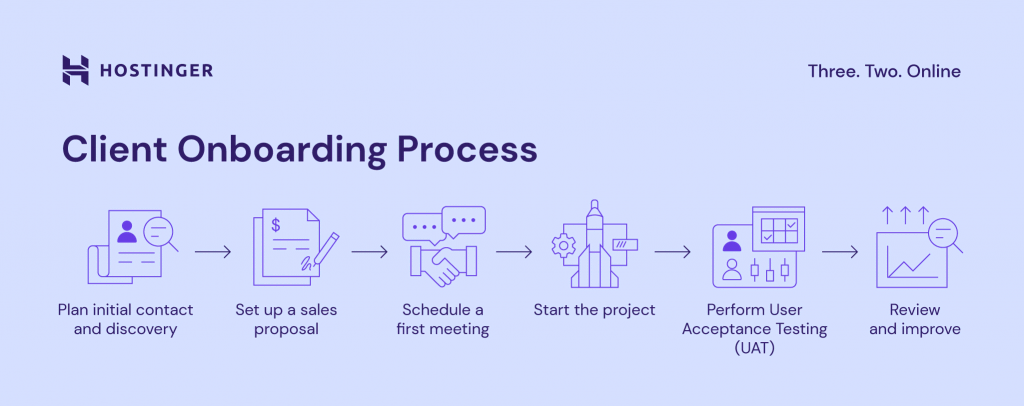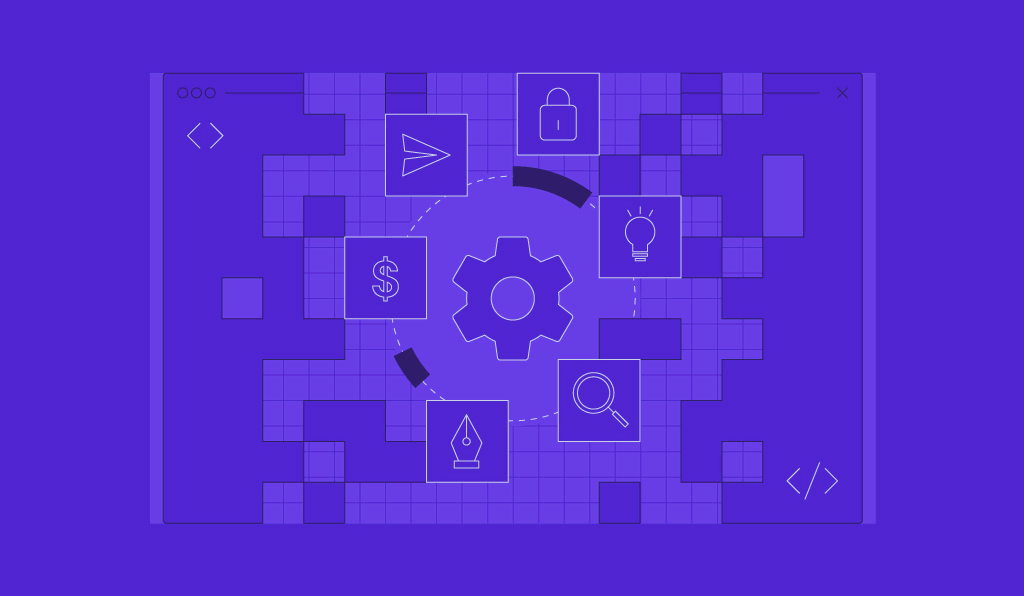Onboarding New Clients: How to Create Onboarding Process + Checklist
After qualifying prospects, it’s time to onboard your new clients. Client onboarding is a crucial aspect of any business, as it sets the foundation for your future relationship.
A well-designed client onboarding process can help businesses establish trust, understand client needs, and set expectations. This will result in client satisfaction and retention, thus increasing your revenue.
In this article, we’ll provide a comprehensive guide to the customer onboarding process, including a checklist to ensure you cover all the important aspects. We’ll also provide practical tips and strategies to create your own effective client onboarding process.
Download Business Plan Template
What Is Client Onboarding?
Client onboarding is the process of familiarizing clients with a business and helping them get started with the company’s products or services. This typically starts after the client chooses the business and continues until the client is fully integrated into the workflow.
Why Client Onboarding Is Important
Before we explore the tips and checklist, you need to understand why the onboarding process is crucial. Here are a few reasons why well-executed onboarding processes are vital:
- Make a positive first impression. The first interaction between a client and a business can leave a lasting impression. A bad onboarding process can harm the client relationship right from the start, and it’s the third most important cause of customer churn.
- Clear expectations. Set your client’s expectations for your business, including delivery dates, communication methods, and your products and services.
- Understand client needs. Gather important project details about the client’s requirements, objectives, and preferences using surveys or in-person meetings.
- Build trust. Onboarding demonstrates your expertise, knowledge, and commitment to client goals.
- Increase retention. Effective onboarding boosts customer retention by meeting their needs and ensuring satisfaction. This leads to a positive long-term relationship and higher revenue.
How to Create a Customer Onboarding Process
A good onboarding process involves several elements. They include planning the first contact, setting up proposals, and scheduling the onboarding meeting. We’ll explain in detail below.
1. Plan Initial Contact and Discovery
The first step of client onboarding is learning about their needs and goals. A client onboarding questionnaire can help you tailor the process to better serve their needs.
The typical areas to cover in an onboarding questionnaire are personal details, business goals, challenges, experience, expectations, decision-making, schedule, budget, and optional remarks.
Here are a few questions to serve as inspiration while creating an onboarding questionnaire:
- What are your business goals and objectives?
- What specific products or services are you interested in?
- What is your preferred mode of communication?
- What is your timeline for completion?
- Who are your target customers or clients?
- What are the unique pain points in your industry?
- What is your budget for this project?
- What are your competitors doing?
- What do you hope to achieve through this partnership?
- Who will be the project’s point of contact?
Use survey tools like Google Forms, Survey Monkey, or Typeform to create onboarding questionnaires.
2. Set Up a Sales Proposal
Once you get the questionnaire’s answers, create a sales proposal that suits your client. This document explains what the client needs, what solution the reader offers, and the cost and timeline.
A sales proposal also clarifies the responsibilities of both parties. This helps set clear expectations, build trust, and prevent any confusion.
While a proposal varies according to the business type, a sales proposal generally should have the following elements:
- Executive summary. A brief overview of the problem statement by the new client and the solution you propose.
- Scope of work. A list of products or services that the client will receive.
- Timeline. An explanation of the time required to complete the project.
- Cost. A breakdown of the exact costs with pricing tables.
- Contact. Information about the service provider’s contact details, including the email, phone number, and website.
Download Web Development Proposal Template
3. Schedule a First Meeting
This onboarding stage gives you the opportunity to introduce your business and discuss the sales proposal. It’s also a chance to give a positive first impression.
The kick-off call ensures everyone is on the same page and allows for effective collaboration. Below are some points to cover during the first onboarding meeting:
- What the new client considers a successful outcome. Ask about their definition of success to align expectations and further understand the client’s goals.
- Review the agreed-upon objectives. Review and discuss deliverables to ensure mutual understanding.
- Establish a communication schedule. Set clear agreements on communication frequency, topics, and channels throughout a specific period.
- Highlight action items. Outline action items for both parties to clarify responsibilities and deadlines for each task.
4. Start the Project
Offer your clients the necessary support during the project. This helps your client use the service or product you provide effectively, increasing customer satisfaction.
Suppose you’re making a WordPress website for a particular client. In that case, it’s necessary to create an admin account, review the sitemap with them, and prepare documentation to assist them with site management. This helps them effectively utilize the website you designed.
It’s also important to assign a dedicated person who will serve as the client’s primary point of contact. This ensures effective communication and project management.

5. Perform User Acceptance Testing (UAT)
During the new client onboarding process, performing the UAT is crucial to ensure the project meets the client’s expectations.
After the project is completed, the new client should thoroughly evaluate the project to ensure it meets their requirements and functions as expected. The process usually involves describing the deliverables, defining the test questions, and collecting client feedback.
Suggested Reading
6. Review and Improve
Regularly reviewing the ongoing project with the client is important to identify areas that need assessment and ensure you’ll deliver the desired outcomes. Working with the client to understand their preferences and requirements can improve and adjust the onboarding process for future customers.
This review process can take different forms, such as a check-in call after a set period or a feedback form. You can also use collaboration tools to make the process easier.
For more client management tips, read these:
Ideal Client Profile
Customer Reporting
Best Client Management Software
New Client Onboarding Checklist
Following a checklist can help you create a successful client onboarding experience for both parties. We’ll explore the new customer onboarding checklist below.
Send Welcome Documents
Sending a welcome document with relevant information will leave an excellent first impression.
The package can include physical or digital documents depending on the company’s style. It can be formal with a CEO letter or casual with fun facts and team introductions.
Depending on the product or service, the package may also include FAQs, contact details, and a signup process. We recommend sending the package after the kickoff meeting.
To make clients feel valued, we suggest sending a welcome email that includes their objectives, their company’s mission statement, or any specific detail that was discussed during the first meeting.
Get Your Contracts in Order
Contracts play a critical role in protecting both parties and setting expectations for the project’s scope and deliverables. Usually, these contracts include:
- Service agreements. List the services, scope of work, deliverables, and other pertinent project details in this section. It is essential to avoid scope creep by providing both parties with clear expectations.
- Timeline and duration. Include a timeline that outlines the project’s expected start and end dates, as well as any key milestones or deadlines. This section helps manage expectations and keeps the project on track.
- Confidentiality. Explain how you keep the client’s confidential information and who can access it during the project, including storage details and measures to prevent unauthorized disclosure.
- Termination. Outline how either party can end the contract, including the notice period and steps to close the project. It’s essential to safeguard both parties if the project doesn’t work out or needs to be canceled.
- Payment terms. Explain the payment terms for the project, including the schedule, method, and late fees or interest charges. This ensures the client understands their financial responsibilities and helps avoid payment disputes.
- Other terms and conditions. Include other project-related details like warranties, intellectual property rights, necessary additional services, and applicable laws or regulations. It’s important to ensure that both parties understand all relevant terms and conditions to prevent misunderstandings or disputes.
To ensure compliance, a good service provider should also review applicable laws and regulations, such as data privacy or copyright laws.
Prepare the Finance Forms
Finance plays a crucial role in the client onboarding workflow. You need to prepare and send the necessary forms for completion and signature, which include credit applications, billing authorizations, and any other financial documents.
It’s also important to log agreed-upon rates and ensure accurate and timely invoicing according to the billing schedule with the new client. This process is critical to keep the project’s finances on track. You will be paid on time and the client will be billed fairly.
In addition to payment-related documents, clients may request tax-related information and records, as well as statements and confirmations for audits and controllers. To streamline the workflow, automate the process through finance software.
Open Communication Lines
Open communication lines are crucial for successful collaboration with clients. Schedule regular calls with the client to keep them updated on the project’s progress, address questions or concerns they may have, and foster a positive working relationship.
Adding clients on all necessary communication channels, such as email, phone, and project management tools, is important to ensure easy access to any updates.
By communicating with clients well and being proactive in scheduling calls, clients are more likely to feel valued and confident in the project’s progress.
Furthermore, to look more professional when communicating with clients, consider getting a business email account.

Create a Project Management Plan
Creating a project management plan starts with a project discovery phase. It involves setting up systems that enable effective collaboration, tracking progress, and meeting deadlines. One crucial aspect of this is adding the client to all necessary project management software to keep them informed about timelines and progress.
This includes setting up to-do lists, assigning tasks, and establishing deadlines for each project stage. With the client added to the project management system, they can stay up-to-date with the project’s progress, view the assigned tasks, and communicate with the project team about any concerns or questions they may have.
Involving the client in the project management process establishes transparency and accountability, which builds trust and confidence in the project team. Additionally, it ensures that everyone is working towards the same goals, minimizing miscommunications.
What to Do After Onboarding a New Client
After you finish the customer onboarding process, do the following steps:
- Ask for feedback. Asking for feedback shows that you care about the client’s satisfaction and are committed to providing the best service possible. It can also help identify areas for improvement.
- Follow up. Regularly checking in with clients after onboarding ensures that you meet all their needs and address every issue. This demonstrates a commitment to ongoing support and value for their business.
- Maintain customer relationships. Regular contact beyond the onboarding process through various communication channels can strengthen the ongoing relationship and ensure long-term customer loyalty.
- Evaluate metrics and measurement. Tracking customer satisfaction, client retention rates, and revenue can provide insight into the effectiveness of the onboarding process and identify areas for improvement.
- Optimize the process. Refining the onboarding process based on feedback and metrics can improve the experience and ensure future potential clients’ success. Also, set up necessary training and resources for your team to continuously improve.
- Request client referrals. By asking for referrals, you can get new customers, thus increasing your revenue.
Conclusion
Client onboarding refers to the process of familiarizing new clients with your business. It helps with building relationships with new clients and increasing the chance of customer retention. Therefore, it’s important to make the onboarding process effective.
In this article, we’ve learned to create a good client onboarding process. You must plan the first contact, set up the proposal, arrange the initial onboarding call, start the project, and perform an acceptance test. Finally, you must review and improve every aspect of the project.
We’ve also covered a sample client onboarding checklist to follow and the post-onboarding tips. Now, you can create your own onboarding process. Leave a comment below if you have any questions.
Onboarding New Clients FAQ
The section below answers the most common questions about onboarding clients.
How Long Does the Onboarding Process Take?
Client onboarding varies in duration depending on factors like project scope, client size, and company resources. It can last from a few days to several weeks. Avoid rushing through the process to prevent misunderstandings, unfulfilled expectations, and negative experiences for the client.
Who Needs a Client Onboarding Process?
All businesses that offer products or services to clients need a client onboarding process. It’s especially important for businesses that rely on long-term clients or repeat business. Any business that values client relationships and wants to offer a positive experience should have a comprehensive onboarding process.
What Makes a Good Client Onboarding Process?
A good customer onboarding process should have several important features: well-organized, clear, and personalized to meet each client’s needs.
Communication channels should be open and accessible, and the process should be efficient and smooth. It should also receive ongoing feedback and improvements. By following these guidelines, businesses can create a strong and positive relationship with their clients.
Do You Need a Written Customer Onboarding Document?
A written customer onboarding document is crucial for ensuring consistency and accuracy. It outlines the process, procedures, and information related to products or services, as well as any relevant terms and conditions.
This document guarantees that everyone involved is aware of their responsibilities and can follow a standardized process. It also helps clients understand what to expect during onboarding.


